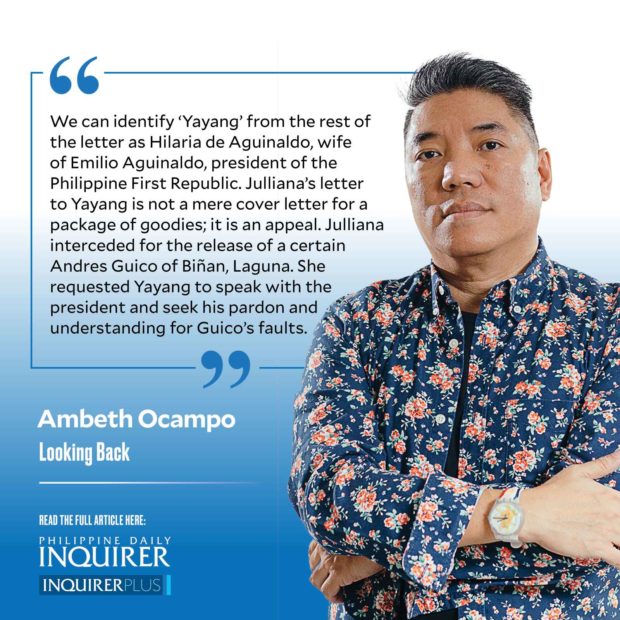‘Yayang,’ HIS-tory, and HER-story
Spouses of Philippine presidents, with the exception of Imelda Marcos who had Cabinet rank as Minister of Human Settlements and Metro Manila governor, are like visible shadows. They are not elected and have no real official duties, aside from cutting ribbons, being at the side of the president when required, and being the Malacañang host.
We have in the roster: one first gentleman, Jose Miguel Arroyo, one first daughter, Vicky Quirino, who acted as “first lady” for President Quirino who was a widower, and a dozen spouses who were first ladies: Hilaria Aguinaldo, Aurora Quezon, Paciencia Laurel, Esperanza Osmeña, Trinidad Roxas, Luz Magsaysay, Leonila Garcia, Eva Macapagal, Imelda Marcos, Amelita Ramos, Loi Ejercito, and Liza Marcos. No one was officially designated or identified as first spouse for Cory Aquino, a widow, and Benigno S. Aquino III, a bachelor. Rodrigo Duterte did not complicate an already complicated life; he did not officially designate a first lady.
Article continues after this advertisementWhile presidential spouses hold no official position, their influence is not to be ignored nor underestimated. Mere proximity to the president in itself is power. Misfiled in the “Katipunan Papers” in the National Library is a document that correctly belongs to the Philippine-American War, the second phase of the revolution. I was drawn to this obscure, two-page, handwritten letter, because it is one of the rare times in the revolutionary records that you find a document written by a woman, Julliana Valerina (Juliana Valeriano in other sources), to another woman addressed as “Yayang.” Sent from Makati and dated July 1, 1898, the letter in formal, florid Tagalog stood out of the pile because Valerina signed herself not as an ordinary citizen but as “Ang asaua ng General Pio del Pilar” (The wife of General Del Pilar).
The letter is on cuadricular or what we call graphing paper today. Text is neat and legible, but by a different hand from Julliana’s signature. This suggests that the text was written by a scribe, and Julliana was not illiterate. She could write out her name in full, instead of signing off with “X.” To give readers a sense of the original, the letter opens:
“Disapalang tua po at tatamuhing galak niaring aking loob na kong sa pagtangap puo niniyo nitong aking sulat ay datnin puo kayong ualang anomang karamdaman o panganib naparris ng salahat puo ng oras ay siya cong ninanasa; kaya ang una puo ay maraming kumusta sa ninyong kamahalan at ang ikalawa puo ay matamisin ng iyo puong loob itong aquing na kayanang ala-ala ko sa inio na isang patang hamon, isang busing na saguing nalakatan at isang kajong pideos na ito puy aking sa iniyo puo ay ala-ala nakahit minamapait puo ng iyong kamahalan ay aring ualang kasing tamis, at isinasanib ko puo sa inyo ay para mo na puong habag sa akin…”
Article continues after this advertisementA rough translation of the above: “It is with happiness and great joy that you are without any illness or danger when you receive my letter, as I wish you well all the time. First, many greetings to your majesty. Second, I hope you will deign to receive some tokens that I could afford: a leg of ham, a bunch of bananas, lakatan variety, and a box of noodles. These tokens I send to your majesty so you will have compassion for me.”
We can identify “Yayang” from the rest of the letter as Hilaria de Aguinaldo, wife of Emilio Aguinaldo, president of the Philippine First Republic. Julliana’s letter to Yayang is not a mere cover letter for a package of goodies; it is an appeal. Julliana interceded for the release of a certain Andres Guico of Biñan, Laguna. She requested Yayang to speak with the president and seek his pardon and understanding for Guico’s faults. Another letter to Yayang in the file is dated Aug. 4, 1898, from a certain S. de Joczon, hand-delivered by Narciso Padernal, “Ang katiwala nitong sulat na lumulohod sa bakas ng iyo pong yapak” (The bearer of this letter who kneels by the trace of your footsteps).
From a photograph of Hilaria de Aguinaldo on horseback and these two letters alone, it is clear that the first first lady of the Philippines exerted more influence outside her humanitarian work, caring for sick and wounded soldiers. More material on Yayang are waiting to be recovered from the archives. Since history is largely based on primary sources by men, or about men, feminist scholars work tirelessly to correct this bias. Finding women hidden in archival records is the first step in balancing HIS-tory and HER-story.
—————–
Comments are welcome at aocampo@ateneo.edu

















